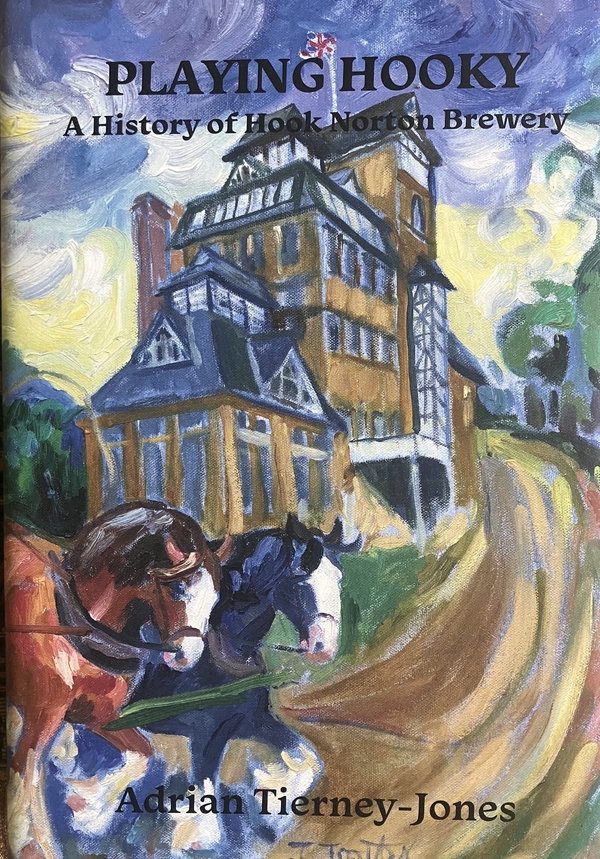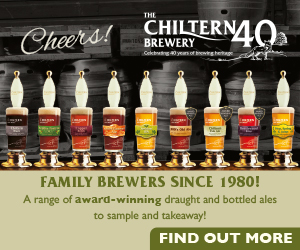Hook Norton, keeping faith with tradition
Added: Tuesday, April 29th 2025

Playing Hooky, Adrian Tierney-Jones (Hook Norton Brewery)
Many breweries have books about them.
They are often worthy but dull, written by retired academics with the ability to research the subject but with little interest in the end product.
Playing Hooky treads a firmer path. Adrian is not only a noted beer writer but also is -- as managing director James Clarke says in awe -- “probably the only man I know who can still function after eight pints of Twelve Days”.
Hook Norton dates from 1849 and in all logic should not have survived in a modern world of global brewers and fizzy Europop. Hook Norton is firmly and wonderfully traditional, with a steam engine and oak brewing vessels.
It concentrates on cask beer brewed in a Victorian tower plant and with shire horses clip clopping to local pubs heaving drays loaded with ale.
The brewery has survived world wars, the coming and going of the railway, Covid and lockdowns and in May 2024 a devastating fire that demolished the stables and other buildings – fortunately with no loss of life to humans or horses.
James Clarke and his team brushed themselves off, rebuilt the damaged buildings and went back to brewing fine ale for pubs in Oxfordshire and surrounding areas.
The original brewery was built by John Harris, a farmer who supplied grain and malt to local brewers and pubs and who took the logical step of making his own beer. By 1872 he had built a three-storey plant in the village of Hook Norton.
He passed the business to his relations, the Clarkes. Starting with Alban Clarke and leading through the generations to James Clarke today, the brewery has steadfastly remained true to ale made with the finest ingredients and allowed to mature and condition in the cask.
Hook Norton is acclaimed for its fine architecture, a Grade II listed plant built in 1900, It was the work of William Bradford, famous for designing a number of tower breweries at the time. They include Harvey’s in Lewes and the much-missed Tolly Cobbold in Ipswich.
The breweries work on the principle of the brewing process flowing logically from floor to floor by gravity, without the need for pumps and other mechanical devices. Brewing water – liquor in brewer-speak – is stored at the top and is mixed with malt ground in mills.
The grain drops into mash tuns then down to coppers for the boil with hops. The hopped wort then flows down into oak fermenters known as rounds. Finally the beer is racked into casks for its onward journey to pubs, where it will ferment and condition for a few days before being delivered to bars by hand pumps and beer engines.
Production increased in the 1880s when the railway arrived in Hook Norton, with a thirsty army of navvies driving the lines for the iron horse through the Oxford countryside. The station and branch line are no longer there, victims of the infamous cuts by Dr Beeching in the 1960s.
For a time in the 20th century, Hook Norton supplied a number of working men’s clubs in the Coventry area, though that trade ended with the decline of heavy industry and the club trade.
The records show that Hook Norton first brewed Mild Ale. That was followed by Stout and, in keeping with the revolution in beer pioneered by Burton-on-Trent, Pale Ale and Bitter.
Stout disappeared during World War One with government restrictions on making roasted grain. But Double Stout has been revived and is now a regular seasonal ale. Hooky Mild, a very modest 2.8 per cent, is still brewed and is a potent link with the origins of the brewery.
But the main beers today are Hooky Best Bitter and the premium Old Hooky. Traditional brewing systems remain though James Clarke has bowed to modern demands with small amounts of keg beer and even – good grief! – lager.
Other changes at the brewery include a spacious visitor centre and a restaurant that provides meals for visitors. A pilot brewery enables members of the brewing team to try out new beers.
The steam engine is no longer in use but it’s turned on occasionally to allow visitors to admire this rumbling artefact of Victorian times. A “coolship”or cooling tray, where hopped wort used to be cooled prior to fermentation, is still in place but is no longer used. James Clarke says he’s been keeping passing yeasts out of the brewery for years and has no intention of producing Belgian-style Lambic beer with wild fermentation.
The book is enlivened by Adrian’s fine writing, fascinating photos of the brewery down the years, and old posters and advertisements. The striking cover is the work of the celebrated artist Josephine Trotter, who has held exhibitions in both London and New York City.
Writer, artist and brewers have combined their skills to produce a book that’s a hymn to the finest traditions of the English countryside, with its mellow villages, welcoming pubs and a glorious glass of traditional ale.
•Hook Norton Brewery, Brewery Lane, Scotland End, Hook Norton, Oxon OX15 5NY. Copies of the book are available from https://www.hooky.co.uk/product/playing-hooky-book/




